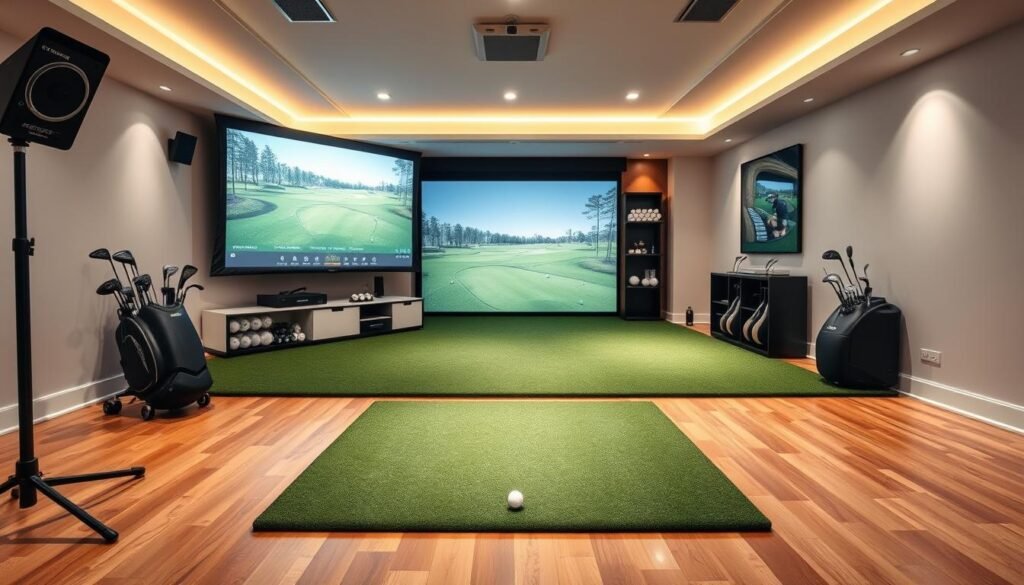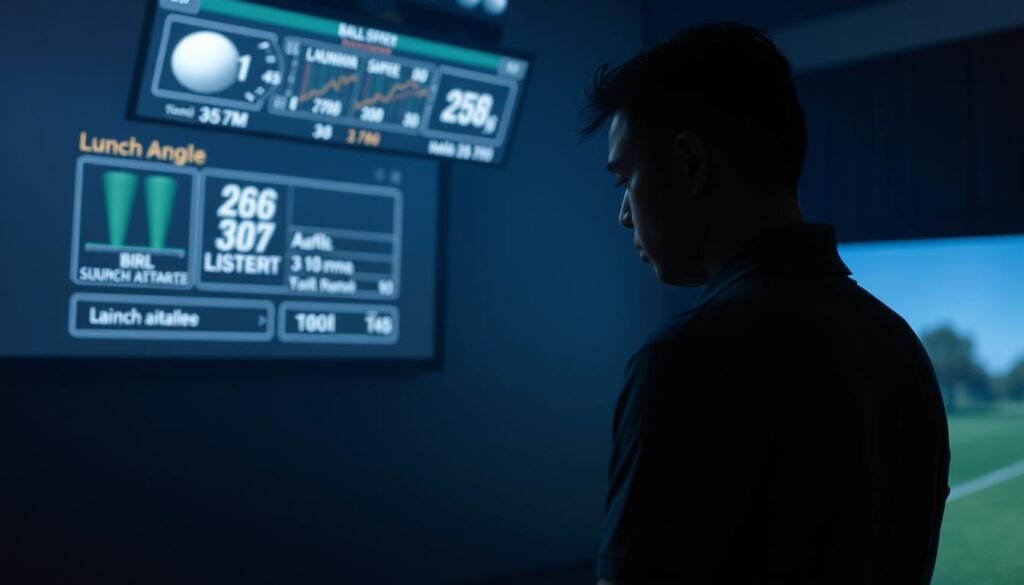Imagine perfecting your swing year-round without stepping outside—sounds ideal, right? While indoor simulation technology revolutionizes practice routines, not every golfer finds these systems deliver on their promises. Behind the convenience lie challenges that could reshape your expectations.
High upfront costs often surprise first-time buyers. Entry-level setups start around $2,000, while premium configurations exceed $10,000. You’ll also need dedicated space—at minimum, a 10’x10’ area with 9-foot ceilings. Even then, some users report persistent gaps between virtual and real-world play.
Putting accuracy remains a common frustration. Sensors might misinterpret soft chips or delicate slopes found on actual greens. The absence of wind resistance and natural terrain variations alters shot outcomes, potentially creating false confidence in your abilities.
Installation hurdles add another layer of complexity. Professional calibration becomes essential for high-end models, requiring additional time and expenses. Ongoing maintenance for projection systems and sensor arrays introduces hidden long-term costs many overlook during initial excitement.
Key Takeaways
- Initial investments range from $2,000 to over $10,000
- Minimum 10’x10’x9’ space required for proper setup
- Putting accuracy and environmental factors differ from real courses
- Professional installation often needed for premium systems
- Ongoing maintenance costs impact long-term value
Understanding the Landscape of Home Golf Simulators
Indoor golf technology has exploded in popularity, creating a maze of choices for players seeking year-round practice. From compact setups to luxury installations, manufacturers promise to bring championship courses into your living space. But how do these systems actually perform when you unbox them?

Exploring the Appeal and Applications
Budget-friendly models ($2,000-$5,000) tempt golfers with plug-and-play convenience. These entry-level packages often include:
- Basic swing analysis tools
- Limited course selection
- Modifiable components for future upgrades
Premium systems start at $10,000, boasting military-grade sensors and customizable environments. One industry insider notes: “High-end users get weather simulations and exact turf textures, but that complexity demands serious commitment.”
Setting the Stage for a Pros and Cons Analysis
Marketing materials showcase pristine virtual fairways, yet reality often delivers uneven experiences. You might love playing Pebble Beach in December, but will the system detect your flop shot’s spin correctly? While 85% of buyers report improved driving accuracy, only 63% say their short game translates to real greens.
The indoor golf boom creates paradoxes. More options mean tougher decisions about what features actually improve your game versus what simply looks impressive. Next, we’ll examine how these tradeoffs impact daily use and long-term satisfaction.
What are the Downsides of Golf Simulators
While indoor systems offer year-round access to digital fairways, they create artificial conditions that alter skill development. Missing environmental feedback changes how you interpret results compared to actual course play.

Limited Realism and Data Constraints
Launch monitors sometimes misread shots under 50 mph, particularly putts and chips. Without actual wind resistance, your swing mechanics develop differently. “You’ll groove a motion that works indoors but falters outdoors,” notes a PGA teaching pro.
Uneven lies and rough terrain disappear in simulations. Every shot starts from perfect turf conditions, eliminating the challenge of adapting to real course obstacles. Data discrepancies become clear when comparing virtual and actual wedge spin rates.
| Feature | Entry-Level Systems | Premium Systems |
|---|---|---|
| Shot Tracking | Basic swing metrics | Advanced spin analysis |
| Environmental Effects | Wind simulation only | Slope & weather modeling |
| Course Details | Generic textures | LiDAR-scanned greens |
High Upfront Cost and Complex Setup
Basic packages start at $2,000 but lack essential features. True-to-life systems require $10,000+ investments before accounting for installation. You’ll need electricians for lighting setups and technicians for sensor calibration.
Ongoing costs add up quickly. Software subscriptions average $300/year, while replacement impact screens cost $1,200 every 18-24 months. Many users report spending 40% more than initial budgets suggest.
Also read: Are Golf Lessons on a Simulator Worth It?
Technical and Environmental Limitations
Golf simulators promise precision, but hidden technical gaps often undermine their training value. Between inconsistent readings and spatial compromises, you’ll face obstacles that no marketing brochure mentions.
Inaccuracies in Swing and Shot Data
Launch monitors struggle with shots below 50 mph. Putts and chips frequently show distorted spin rates or launch angles. “The tech excels with drivers but guesses on delicate pitches,” admits a simulator technician.
Three critical flaws emerge:
- Misread backspin on bunker shots
- Ignored sidehill lies during approach calculations
- Overestimated carry distances in windless simulations
You might groove a perfect indoor swing that collapses on actual slopes. Data discrepancies grow wider as shots require more touch than power.
Challenges with Space and Equipment Installation
That spare room you measured? It likely falls short. Radar systems demand 21 feet of depth—more than most garages offer. Ceiling heights under 9 feet force abbreviated follow-throughs.
Common installation nightmares include:
- Ductwork blocking driver swings
- Garage door tracks limiting ball flight
- Light fixtures dangling in impact zones
One installer reveals: “70% of clients need structural modifications. Basements become construction sites overnight.” Even hitting mats require 10 feet of width—space many urban golfers simply lack.
Practical Considerations and User Experience
Owning a golf simulator transforms more than your practice routine—it reshapes household dynamics and daily priorities. What begins as a tool to improve game skills often becomes a lifestyle commitment with unintended consequences.
Impact on Personal Life and Family Dynamics
Garage conversions and basement installations frequently spark family tensions. One user admitted: “My wife calls it ‘the lab’ now—she hasn’t touched the clubs since setup day.” These systems dominate shared spaces, creating friction when others need storage or parking areas.
Children and partners initially show interest but rarely sustain engagement. Simulators allow solo play, yet the equipment’s complexity intimidates casual users. Over time, what’s marketed as family entertainment becomes a single-golfer domain.
Maintenance, Upgrades, and the Risk of Obsession
Owners spend hours analyzing swing data instead of enjoying rounds. Weekly maintenance tasks include:
- Calibrating infrared sensors
- Updating course libraries
- Replacing worn hitting mats
| Activity | Time Allocation |
|---|---|
| Swing analysis | 45% |
| Troubleshooting | 30% |
| Actual play | 25% |
Upgrade pressures never fade. New 4K projectors and premium launch monitors make existing setups feel outdated. Many golfers report spending more time tweaking settings than practicing their short game.
Despite promises of convenience, 62% of users play less than twice weekly. Work schedules and family duties shrink simulator time to fragmented sessions. Buyer’s remorse often follows when reality clashes with expectations of seamless improvement.
Also read: Golf Simulator: The Ultimate Beginner’s Guide
Conclusion
Navigating the world of indoor golf tech requires balancing ambition with reality. While launch monitors track swing speed and ball flight indoors, they can’t replicate morning dew on fairways or unpredictable breezes. Your garage setup might let you play golf daily, but grooving swings on perfect mats creates false confidence for uneven lies.
Price remains a decisive factor. Entry-level systems costing $2,000 lack advanced features, while premium packages demand $10,000+ investments before installation. Even mid-range options struggle with accurate short game analysis—critical for improving real course performance.
Yet advantages persist. Weather-proof practice sessions and instant shot data help refine your swing mechanics year-round. Many golfers find value in replaying iconic holes or diagnosing launch angles between work commitments.
Test systems at local facilities before purchasing to gauge how simulated conditions align with your real-world play style. This hands-on approach reveals whether projected improvement justifies the costs and space sacrifices. As tech evolves, newer models address past flaws—but core gaps between virtual and actual golf endure.